Abstract
Acid metabolic products of 23 strains of human and animal pathogenic corynebacteria, representing eight different species, were determined by gas chromatography. The results showed that the species examined were metabolically heterogeneous and could be presumptively identified based on the acid products produced. Corynebacterium equi did not produce any acids; C. renale produced lactate; and C. pyogenes produced major amounts of lactate, variable amounts of acetate, and minor amounts of succinate and pyruvate. C. kutscheri produced propionate and lactate as major products and pyruvate and oxalacetate as minor products. C. diphtheriae and C. pseudotuberculosis produced major amounts of propionate, acetate, and formate. In addition, C. pseudotuberculosis produced major amounts of pyruvate and minor amounts of succinate, lactate, and oxalacetate, whereas C. diphtheriae strains produced minor but variable amounts of lactate, succinate, fumarate, pyruvate, and oxalacetate. C. bovis produced aicd products similar to those of C. pyogenes but was readily distinguishable from the latter by the lack of hemolysis on blood agar, colony morphology, catalase reaction, and biochemicals. C. suis characteristically produced major amounts of ethanol, acetate, and formate and minor amounts of lactate and succinate but no propionate.
Full text
PDF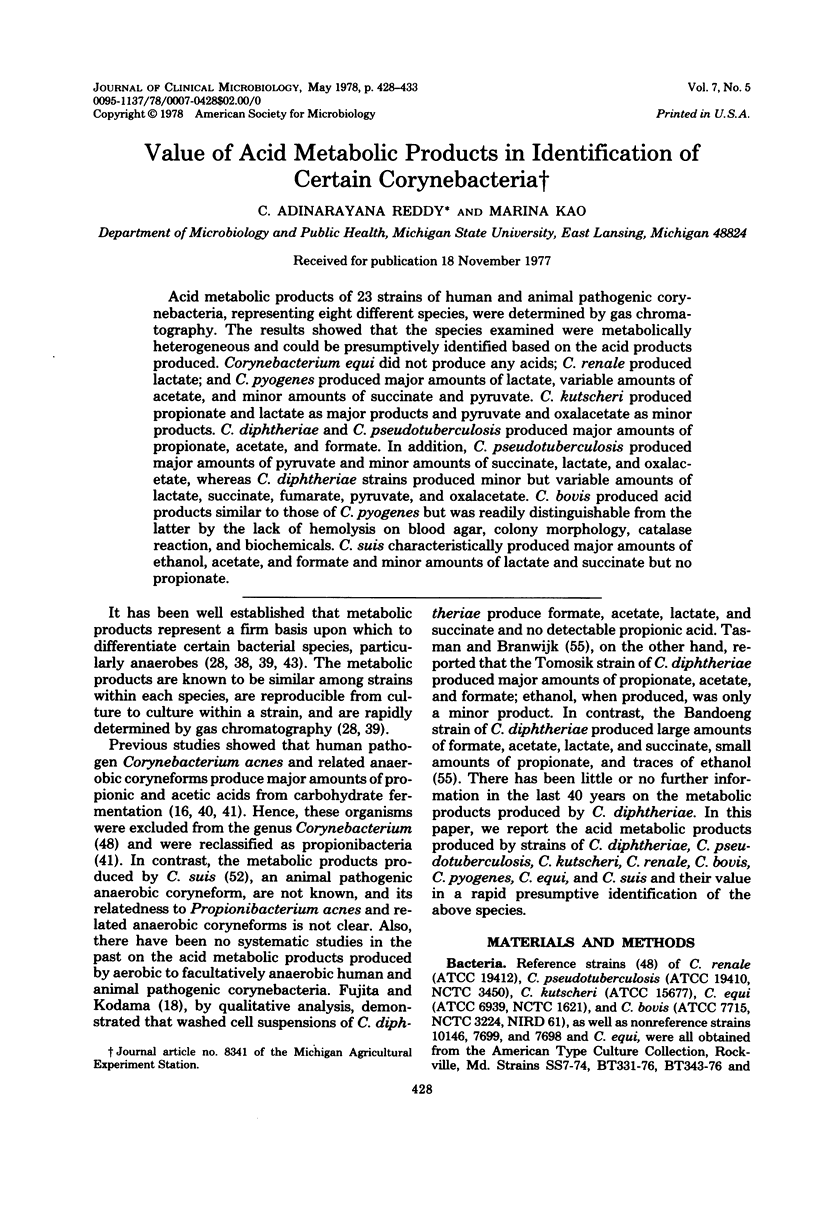
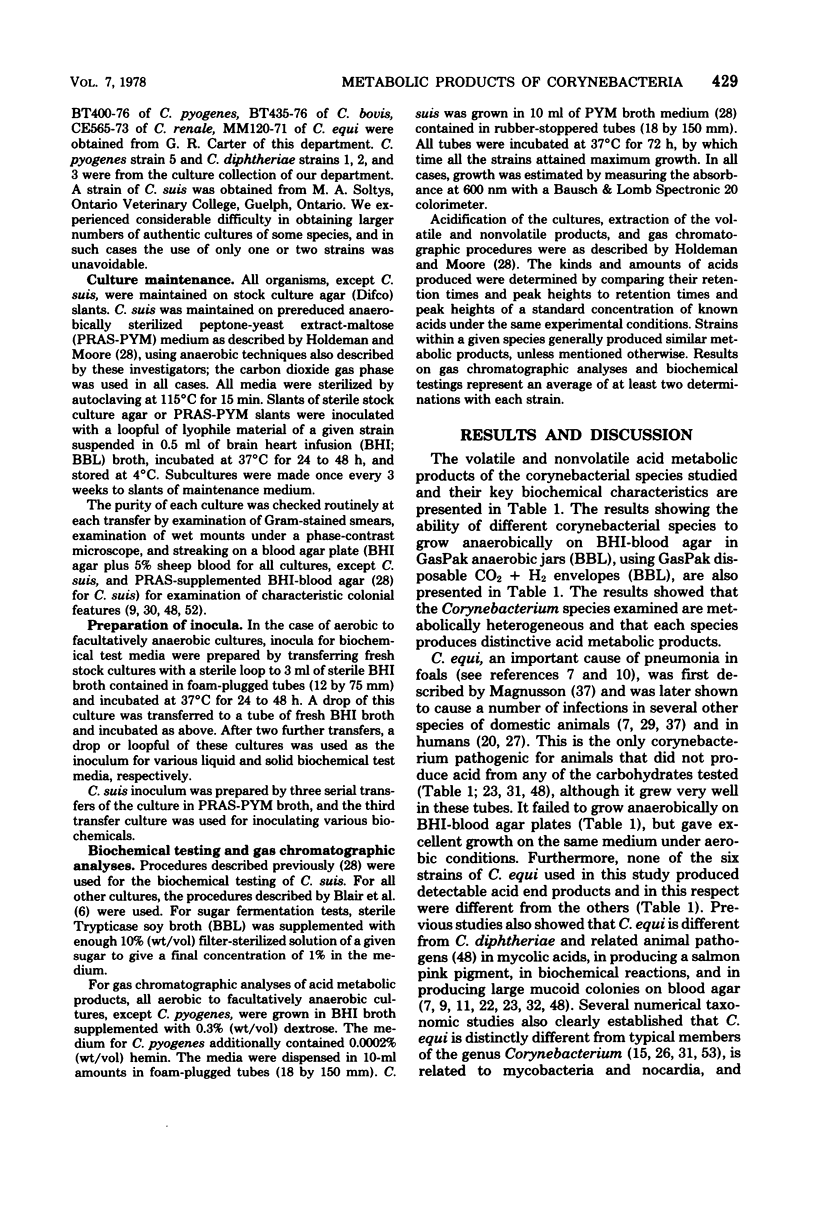
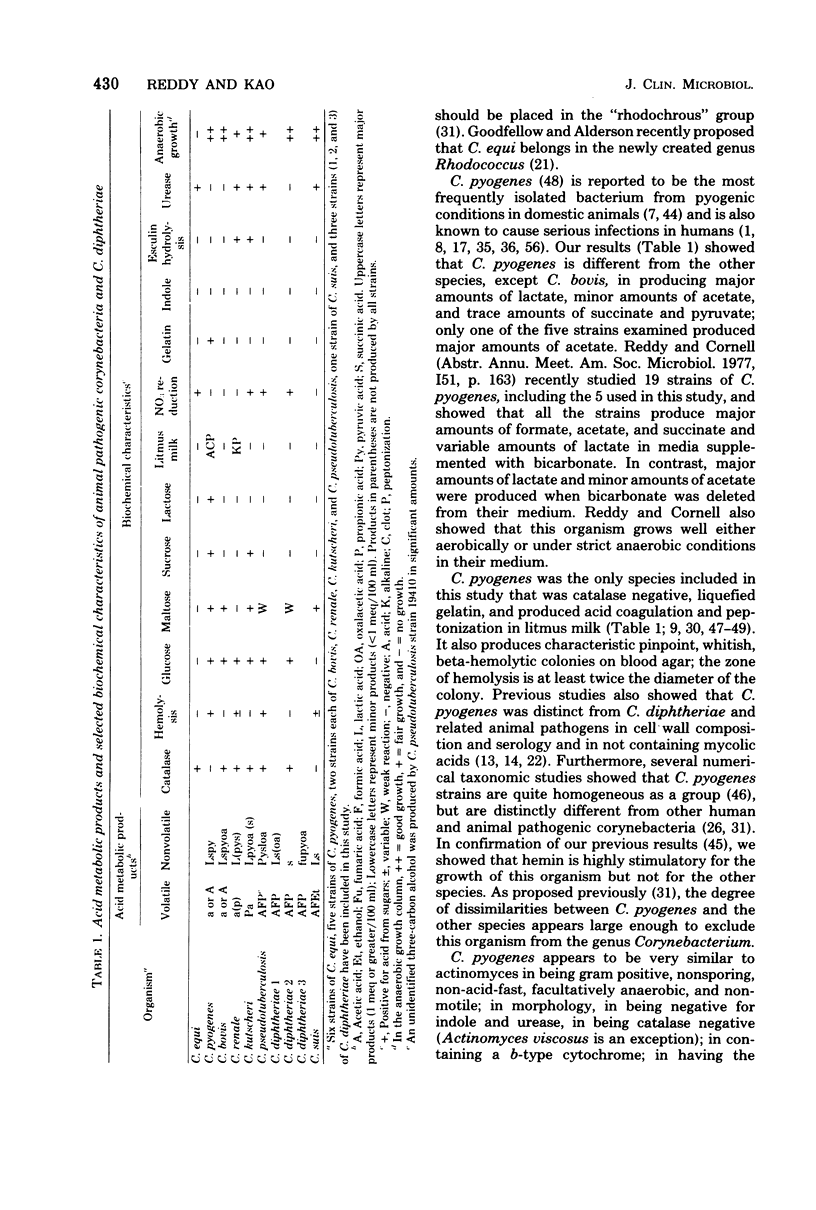
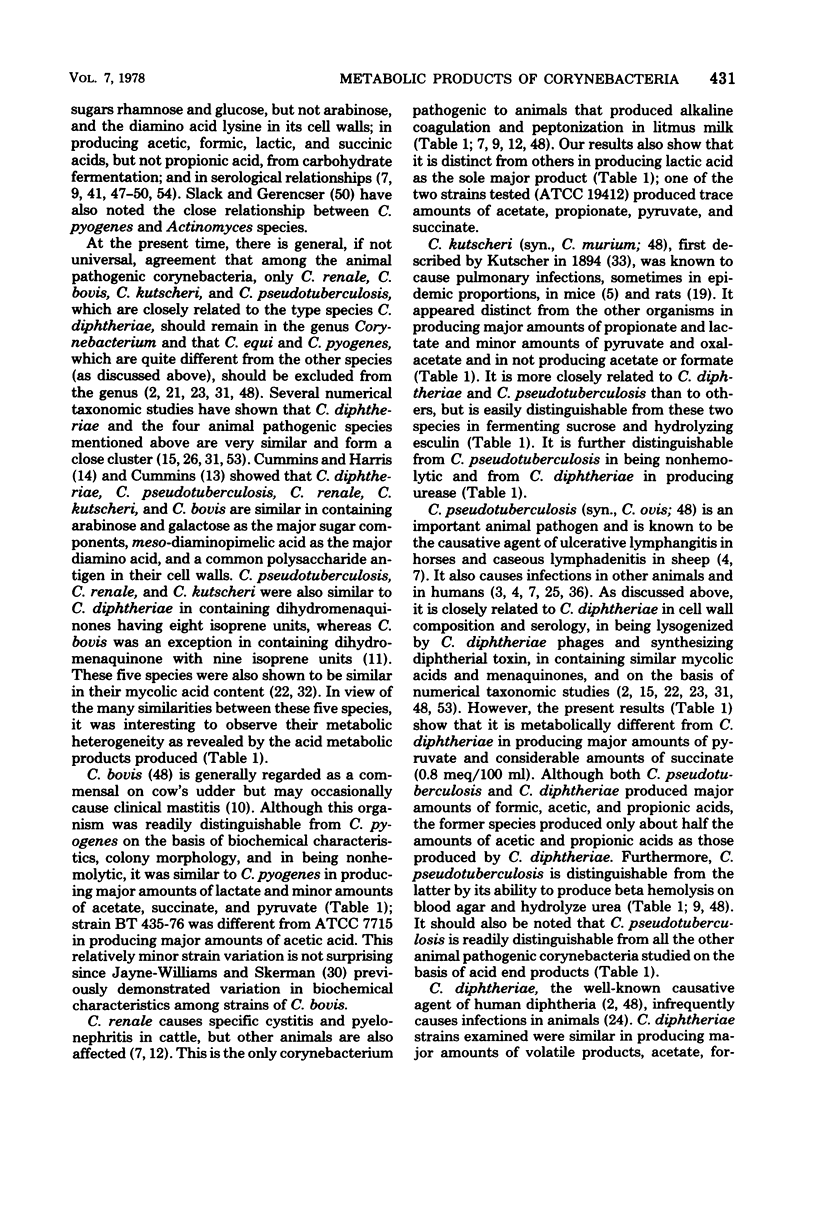
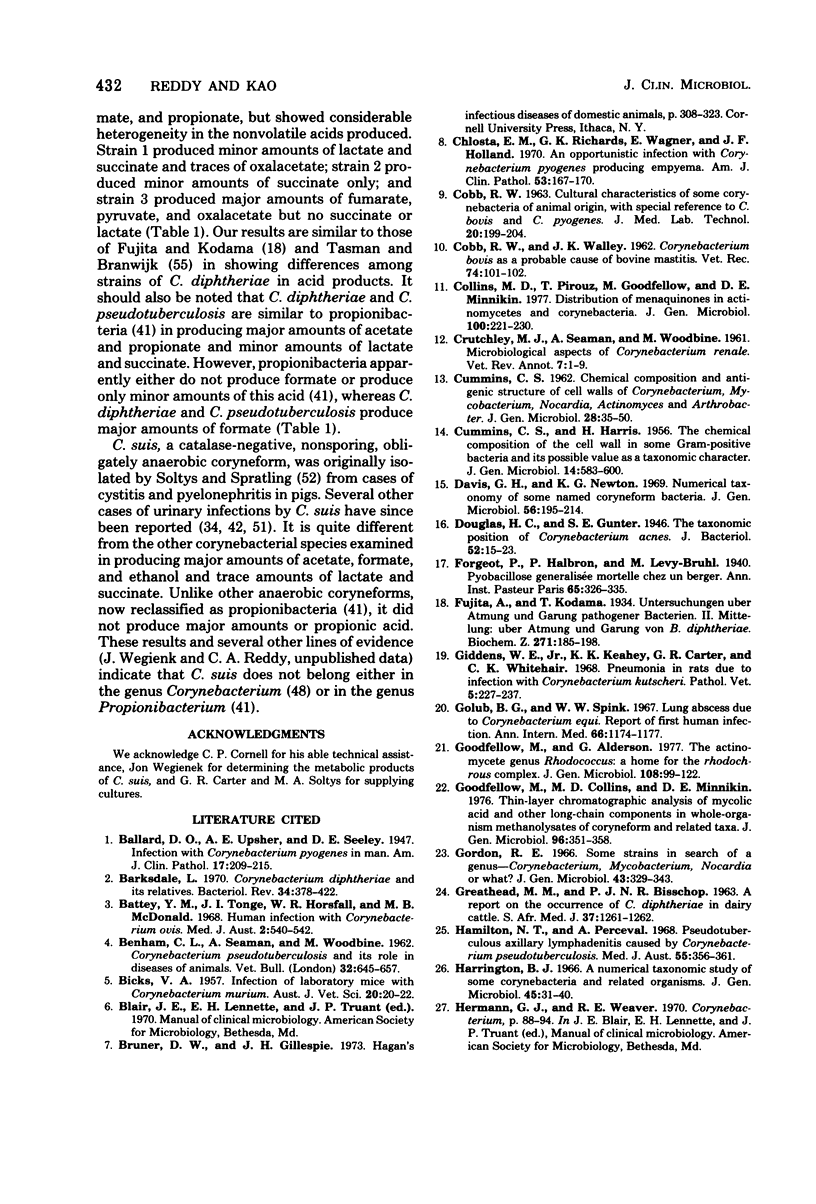
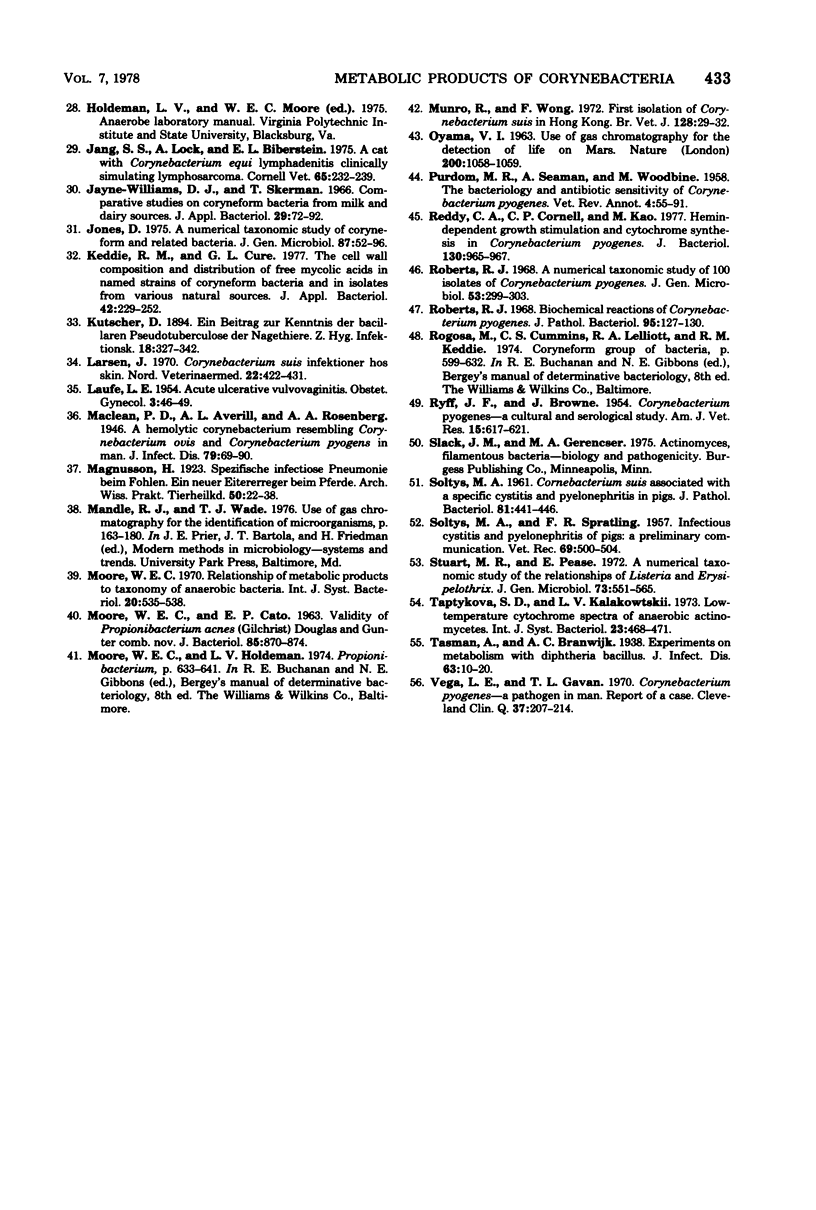
Selected References
These references are in PubMed. This may not be the complete list of references from this article.
- BENHAM C. L., SEAMAN A., WOODBINE M. Corynebacterium pseudotuberculosis and its role in diseases of animals. Vet Bull. 1962 Oct;32:645–657. [PubMed] [Google Scholar]
- Barksdale L. Corynebacterium diphtheriae and its relatives. Bacteriol Rev. 1970 Dec;34(4):378–422. doi: 10.1128/br.34.4.378-422.1970. [DOI] [PMC free article] [PubMed] [Google Scholar]
- Battey Y. M., Tonge J. I., Horsfall W. R., McDonald I. R. Human infection with Coryne-bacterium ovis. Med J Aust. 1968 Sep 28;2(13):540–543. doi: 10.5694/j.1326-5377.1968.tb83005.x. [DOI] [PubMed] [Google Scholar]
- COBB R. W. CULTURAL CHARACTERISTICS OF SOME CORYNEBACTERIA OF ANIMAL ORIGIN, WITH SPECIAL REFERENCE TO C. BOVIS AND C. PYOGENES. J Med Lab Technol. 1963 Jul;20:199–204. [PubMed] [Google Scholar]
- CUMMINS C. S. Chemical composition and antigenic structure of cell walls of Corynebacterium, Mycobacterium, Nocardia, Actinomyces and Arthrobacter. J Gen Microbiol. 1962 Apr;28:35–50. doi: 10.1099/00221287-28-1-35. [DOI] [PubMed] [Google Scholar]
- CUMMINS C. S., HARRIS H. The chemical composition of the cell wall in some gram-positive bacteria and its possible value as a taxonomic character. J Gen Microbiol. 1956 Jul;14(3):583–600. doi: 10.1099/00221287-14-3-583. [DOI] [PubMed] [Google Scholar]
- Chlosta E. M., Richards G. K., Wagner E., Holland J. F. An opportunistic infection with Corynebacterium pyogenes producing empyema. Am J Clin Pathol. 1970 Feb;53(2):167–170. doi: 10.1093/ajcp/53.2.167. [DOI] [PubMed] [Google Scholar]
- Collins M. D., Pirouz T., Goodfellow M., Minnikin D. E. Distribution of menaquinones in actinomycetes and corynebacteria. J Gen Microbiol. 1977 Jun;100(2):221–230. doi: 10.1099/00221287-100-2-221. [DOI] [PubMed] [Google Scholar]
- Davis G. H., Newton K. G. Numerical taxonomy of some named coryneform bacteria. J Gen Microbiol. 1969 May;56(2):195–214. doi: 10.1099/00221287-56-2-195. [DOI] [PubMed] [Google Scholar]
- Douglas H. C., Gunter S. E. The Taxonomic Position of Corynebacterium acnes. J Bacteriol. 1946 Jul;52(1):15–23. [PMC free article] [PubMed] [Google Scholar]
- GREATHEAD M. M., BISSCHOP P. J. A REPORT ON THE OCCURRENCE OF C. DIPHTHERIAE IN DIARY CATTLE. S Afr Med J. 1963 Dec 14;37:1261–1262. [PubMed] [Google Scholar]
- Giddens W. E., Jr, Keahey K. K., Carter G. R., Whitehair C. K. Pneumonia in rats due to infection with Corynebacterium kutscheri. Pathol Vet. 1968;5(3):227–237. doi: 10.1177/030098586800500304. [DOI] [PubMed] [Google Scholar]
- Golub B., Falk G., Spink W. W. Lung abscess due to Corynebacterium equi. Report of first human infection. Ann Intern Med. 1967 Jun;66(6):1174–1177. doi: 10.7326/0003-4819-66-6-1174. [DOI] [PubMed] [Google Scholar]
- Goodfellow M., Alderson G. The actinomycete-genus Rhodococcus: a home for the "rhodochrous" complex. J Gen Microbiol. 1977 May;100(1):99–122. doi: 10.1099/00221287-100-1-99. [DOI] [PubMed] [Google Scholar]
- Goodfellow M., Collins M. D., Minnikin D. E. Thin-layer chromatographic analysis of mycolic acid and other long-chain components in whole-organism methanolysates of coryneform and related taxa. J Gen Microbiol. 1976 Oct;96(2):351–358. doi: 10.1099/00221287-96-2-351. [DOI] [PubMed] [Google Scholar]
- Gordon R. E. Some strains in search of a genus--Corynebacterium, Mycobacterium, Nocardia or what? J Gen Microbiol. 1966 Jun;43(3):329–343. doi: 10.1099/00221287-43-3-329. [DOI] [PubMed] [Google Scholar]
- Hamilton N. T., Perceval A., Aarons B. J., Goodyear J. E. Pseudotuberculous axillary lymphadenitis caused by Corynebacterium pseudotuberculosis. Med J Aust. 1968 Aug 24;2(8):356–361. doi: 10.5694/j.1326-5377.1968.tb26819.x. [DOI] [PubMed] [Google Scholar]
- Jang S. S., Lock A., Biberstein E. L. A cat with Corynebacterium equi lymphadenitis clinically simulating lymphosarcoma. Cornell Vet. 1975 Apr;65(2):232–239. [PubMed] [Google Scholar]
- Jones D. A numerical taxonomic study of coryneform and related bacteria. J Gen Microbiol. 1975 Mar;87(1):52–96. doi: 10.1099/00221287-87-1-52. [DOI] [PubMed] [Google Scholar]
- Keddie R. M., Cure G. L. The cell wall composition and distribution of free mycolic acids in named strains of coryneform bacteria and in isolates from various natural sources. J Appl Bacteriol. 1977 Apr;42(2):229–252. doi: 10.1111/j.1365-2672.1977.tb00689.x. [DOI] [PubMed] [Google Scholar]
- LAUFE F. E. Acute ulcerative vulvovaginitis due to Corynebacterium pyogenes. Obstet Gynecol. 1954 Jan;3(1):46–49. [PubMed] [Google Scholar]
- MOORE W. E., CATO E. P. VALIDITY OF PROPIONIBACTERIUM ACNES (GILCHRIST) DOUGLAS AND GUNTER COMB. NOV. J Bacteriol. 1963 Apr;85:870–874. doi: 10.1128/jb.85.4.870-874.1963. [DOI] [PMC free article] [PubMed] [Google Scholar]
- RYFF J. F., BROWNE J. Corynebacterium pyogenes-a cultural and serological study. Am J Vet Res. 1954 Oct;15(57):617–621. [PubMed] [Google Scholar]
- Reddy C. A., Cornell C. P., Kao M. Hemin-dependent growth stimulation and cytochrome synthesis in Corynebacterium pyogenes. J Bacteriol. 1977 May;130(2):965–967. doi: 10.1128/jb.130.2.965-967.1977. [DOI] [PMC free article] [PubMed] [Google Scholar]
- Roberts R. J. A numerical taxonomic study of 100 isolates of Corynebacterium pyogenes. J Gen Microbiol. 1968 Oct;53(3):299–303. doi: 10.1099/00221287-53-3-299. [DOI] [PubMed] [Google Scholar]
- Roberts R. J. Biochemical reactions of Corynebacterium pyogenes. J Pathol Bacteriol. 1968 Jan;95(1):127–130. doi: 10.1002/path.1700950115. [DOI] [PubMed] [Google Scholar]
- Stuart M. R., Pease P. E. A numerical study on the relationships of Listeria and Erysipelothrix. J Gen Microbiol. 1972 Dec;73(3):551–565. doi: 10.1099/00221287-73-3-551. [DOI] [PubMed] [Google Scholar]
- Vega L. E., Gavan T. L. Corynebacterium pyogenes--a pathogen in man. Report of a case. Cleve Clin Q. 1970 Oct;37(4):207–214. doi: 10.3949/ccjm.37.4.207. [DOI] [PubMed] [Google Scholar]


